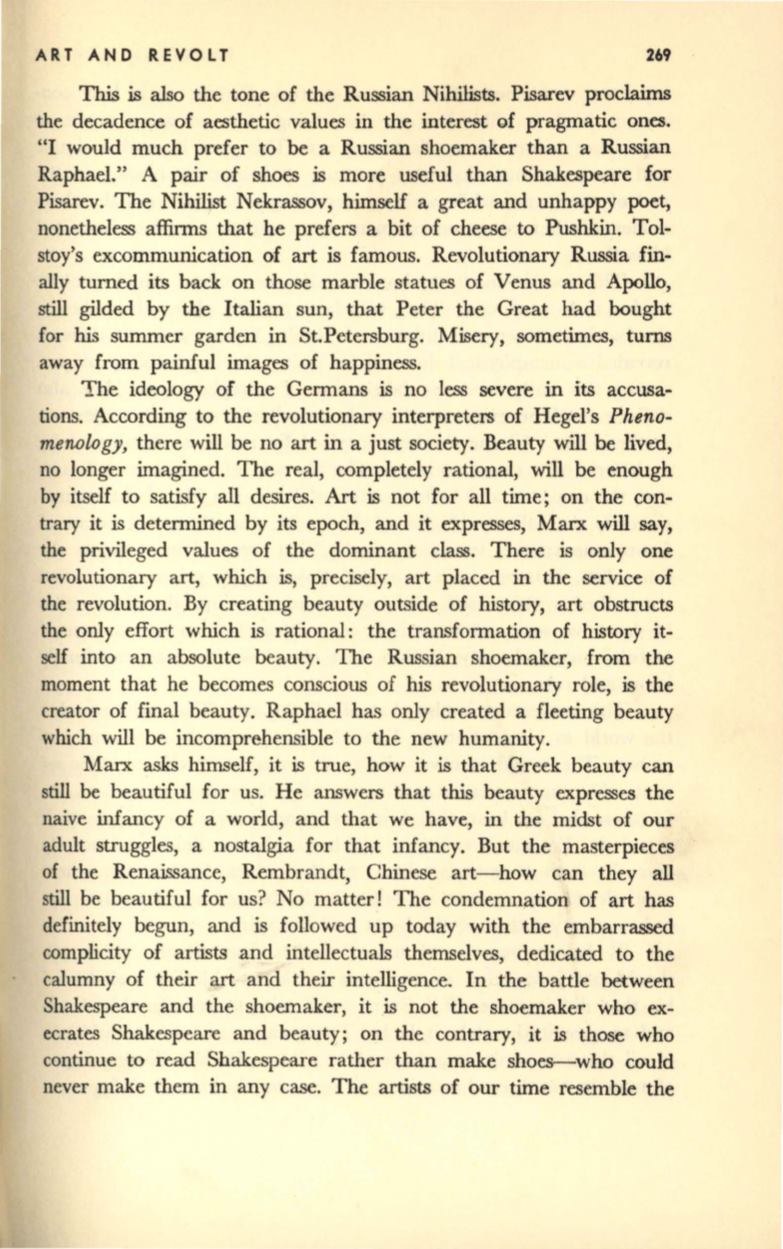
ART AND REVOLT
269
This
is also the tone of the Russian Nihilists. Pisarev proclaims
the decadence of aesthetic values in the interest of pragmatic ones.
"I would much prefer to
be
a Russian shoemaker than a Russian
Raphael." A pair of shoes is more useful than Shakespeare for
Pisarev. The Nihilist Nekrassov, himself a great and unhappy poet,
nonetheless affirms that he prefers a bit of cheese to Pushkin. Tol–
stoy's excommunication of art is famous. Revolutionary Russia fin–
ally turned its back on those marble statues of Venus and Apollo,
still gilded by the Italian sun, that Peter the Great had bought
for
his
summer garden in St.Petersburg. Misery, sometimes, turns
away from painful images of happiness.
The ideology of the Germans is no less severe in its accusa–
tions. According to the revolutionary interpreters of Hegel's
Pheno–
menowgy,
there will be no
art
in a just society. Beauty
will
be lived,
no longer imagined. The real, completely rational, will be enough
by itself to satisfy all desires.
Art
is not for all time; on the con–
trary it
is
determined by its epoch, and it expresses, Marx will say,
the privileged values of the dominant class. There is only one
revolutionary art, which is, precisely, art placed in the service of
the revolution. By creating beauty outside of history, art obstructs
the only effort which is rational: the transformation of history it–
self into an absolute beauty. The Russian shoemaker, from the
moment that he becomes conscious of his revolutionary role, is the
creator of final beauty. Raphael has only created a fleeting beauty
which
will
be incomprehensible to the new humanity.
Marx asks himself, it is true, how it
is
that Greek beauty can
still
be
beautiful for us. He answers that this beauty expresses the
naive infancy of a world, and that we have, in the midst of our
adult struggles, a nostalgia for that infancy. But the masterpieces
of the Renaissance, Rembrandt, Chinese art- how can they all
still be beautiful for us? No matter! The condemnation of art has
definitely begun, and is followed up today with the embarrassed
complicity of artists and intellectuals themselves, dedicated to the
calumny of their
art
and their intelligence. In the battle between
Shakespeare and the shoemaker, it is not the shoemaker who ex–
ecrates Shakespeare and beauty; on the contrary, it is those who
continue to read Shakespeare rather than make shoes--who could
never make them in any case. The artists of our time resemble the


